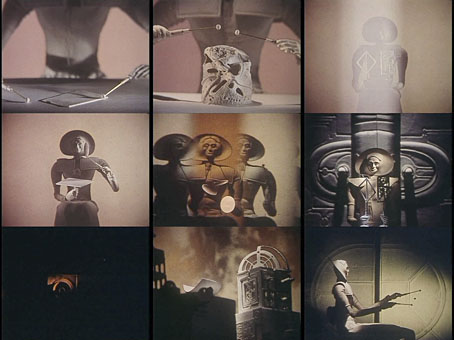
Another gem at Ubuweb, and nothing to do with JG Ballard’s SF story of the same name, Piotr Kamler’s Chronopolis (1983) is a 50-minute animated science fiction film, albeit science fiction of a much more abstract variety than one usually finds in cinema. I’m generally exasperated by the way film and TV SF does little more than play Cowboys & Indians in space so it’s refreshing to see something that’s unashamedly strange and doesn’t feel the need to explain itself. There is apparently a version of this with some English narration for those benighted American audiences everyone feels a need to pander to but the Ubuweb version is wordless, and if you can’t read French then you won’t understand the few lines of text prologue at the opening.

Accompanying Kamler’s beautifully crafted and quite inexplicable scenes there’s an electronic score by composer Luc Ferrari, mostly analogue timbres whose origin is as mysterious as the events taking place on-screen. Kamler’s statuesque figures remind me of the gods and aliens that Moebius and co. were drawing in Métal Hurlant during the 1970s. Chronopolis was a French production begun in 1977 so it’s possible that French comics were an influence. Moebius himself worked on another animated SF film during this period, René Laloux’s Time Masters (1982). Chronopolis is closer in tone to the weirdness of Laloux’s earlier Fantastic Planet (1973), and all the better for it.

Previously on { feuilleton }
• Les Jeux des Anges by Walerian Borowczyk
• Les Temps Morts by René Laloux

Pitor Kamler is genuis whose work deserves to be better known
My band, Odradek, was asked to perform a live soundtrack to this film but we politely declined since we thought there was nothing wrong with Luc Ferrari’s…
That’s good to hear. I don’t mind people providing new scores for silent films but I object strongly to people doing that with more recent films, especially when the score has been carefully created and applied. At the worst it risks making the film seem like a mere backdrop to the band’s performance rather than a work of art in its own right.